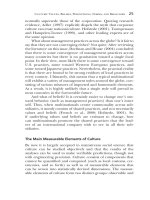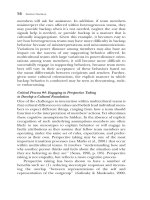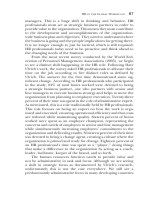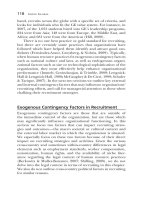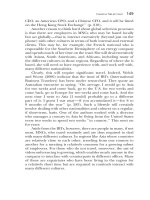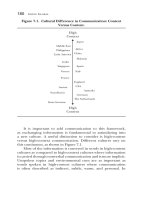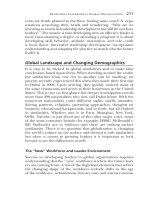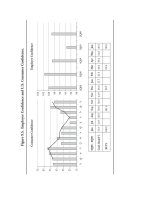Going Global Practical Applications and Recommendations for HR and OD Professionals in the Global Workplace J-B SIOP Professional Practice Series by Kyle Lundby, Jeffrey Jolton and Allen I. Kraut_15 doc
Bạn đang xem bản rút gọn của tài liệu. Xem và tải ngay bản đầy đủ của tài liệu tại đây (456.73 KB, 28 trang )
Maximizing Success and Retention of International Assignees 355
Expatriate compensation is clearly a very sensitive issue for
HCNs (Bonache et al., 2009). Therefore, particular attention
needs to be paid to how the potentially harmful effects of pay
differentials can be avoided or mitigated. The issue of pay differ-
entials can be addressed in two ways: avoiding or reducing them
or, where that is not feasible, to make them as acceptable as possi-
ble (Bonache et al., 2009). In order to avoid or minimize large pay
differentials, companies might give preference to candidates who
are intrinsically motivated to accept an international assignment
(Bonache et al., 2009). This approach, however, risks dissatisfac-
tion on the part of the expatriate due to perceived inequity if he
or she meets other expatriates when on assignment who had to
be ‘‘bribed’’ to go. Meeting and interacting with other expatriates
(and comparing company compensation practices) is inevitable
unless the assignee is the only expatriate in a particular location.
Another option might be to make international assignments a
valued career development intervention (Bonache et al., 2009).
This, however, can only work as an incentive if the company has
a proven track record of recognizing international experience in
their promotion policy (Hippler, 2009).
If a company can make a credible claim that foreign experi-
ence is career enhancing, rewards in terms of pay increases might
be reduced. This would be all the more desirable as it would
reduce one of the most galling forms of pay discrepancy for the
HCNs. An expatriate on a developmental assignment is there to
learn from local staff. Not only do the expatriates have no superior
expertise or skills, they are abroad to benefit from the skills and
experience of the local employees. If this imbalance in knowledge
and skills coincides with an inverse imbalance in pay, it will be
perceived as particularly indefensible by local employees (Toh &
DeNisi, 2005).
Where large pay differentials are unavoidable, recent research
suggests a particular emphasis on selection, training, and trans-
parency. Bonache et al. (2009) show that if HCNs perceive the
expatriates as making unique contributions (such as providing
expert knowledge that is not available locally), they perceive any
pay differential as less unfair. Consequently, unless the assignment
is primarily developmental, only expatriates with genuinely supe-
rior ability should be chosen so that local employees will perceive
356 Going Global
them as deserving of any more generous compensation (Toh &
DeNisi, 2005). The sensitive treatment of locals has also been
shown to diminish the perception of pay unfairness (Bonache
et al., 2009; Chen et al., 2002). Honesty and integrity promote
trustworthiness, which was found to buffer the negative effect of
perceived pay injustice on the overall evaluation of the expatri-
ates (Leung et al., 2009). Therefore, personality characteristics
and interpersonal skills should play a prominent role in selection
decisions and subsequent training. Transparency will facilitate
a careful management of HCNs’ perceptions of justice (Toh &
DeNisi, 2005). Expatriates’ unique contributions as well as their
special financial needs (such as those related to the loss of the
spousal income, fees for international schools, or travel expenses
to look after elderly relatives left behind) were demonstrated to
make pay differentials more acceptable to HCNs (Bonache et al.,
2009). As a result, companies need to raise the HCNs’ aware-
ness of these contributions and needs by communicating them
very clearly and making the mechanisms by which pay packages
are arrived at transparent. Finally, firms should communicate
and emphasize the pay advantages that the HCNs might have
over other local employees in similar organizations and positions,
that is, over another group of relevant referents or ‘‘comparison-
others’’ (Adams, 1963, 1965), thus once more mitigating against
any negative perception of pay differentials (Bonache et al., 2009;
Leung et al., 2009; Toh & DeNisi, 2003, 2005). The design of
expatriate compensation packages must take into account their
larger effect on all groups of employees, including HCNs (Toh
& DeNisi, 2005) to the benefit of both the organization and the
individual expatriate.
Career Progression upon Repatriation
Considering the large investment to develop, maintain, and trans-
fer international assignees, losing an employee with valuable
international experience is costly and can affect the firm’s bottom
line. Moreover, the loss of an internationally proficient employee
often indirectly translates into providing an advantage to direct
competitors, as repatriates are likely to find jobs with competitors,
thus providing them with valuable human assets. In addition, high
Maximizing Success and Retention of International Assignees 357
turnover among repatriates compromises the company’s ability to
recruit future expatriates because it signals to other employees
in the company that, despite the stated message to the contrary,
international assignments may have a negative impact on one’s
career (Downes & Thomas, 1999). Given this strategic human
capital issue, ways to predict repatriate retention and lower their
turnover is an important challenge facing organizations today
(Black, Gregersen, & Mendenhall, 1992a, 1992b; Gregersen &
Black, 1995; Stroh, 1995).
Various factors affect whether international assignees remain
with theircompany upon repatriation, which include being placed
in unchallenging jobs, lack of promotion opportunities, loss of sta-
tus and autonomy, lack of career planning and counseling, lack of
support on behalf of managers and colleagues, and sluggish career
advancement (Adler, 1981; Abueva, 2000; Black et al., 1992b). Of
these many factors, it is not surprising that the most important one
is the repatriates’ perception of how well the firms managed their
repatriation process (Feldman & Thompson, 1993). This suggests
that if the potential repatriation problems are considered, and
appropriately addressedbythefirm inadvance,repatriate turnover
will occur less often (Harvey, 1989). Thus, the repatriates who per-
ceive that they have more support from their organization will be
more committed to that organization—and will be more likely to
stay with it after repatriation.
Repatriates want their companies to value their international
experience. As such, repatriates will mentally calculate an equity
equation: comparing their perceptionsofthe rewards and recogni-
tion that the company has given them for taking the assignment,
relative to the sacrifices and contributions they have made for
their company during the assignment; and the greater the per-
ceived equity, the greater the likelihood that they will remain with
the company upon repatriation. This suggests a type of mental
exchange, or psychological contract, between expatriates and their
employers. The psychological contract is based on the employee’s
overall perceptions of the long-term exchange of fairness with the
company, rather than on any specific (and quantifiable) obligation
(Rousseau, 1990).
Given the perceived sacrifice involved in relocating one’s
family to another country for the sake of the company, it makes
358 Going Global
intuitive sense that the psychological contract would apply to
international assignees upon repatriation (Guzzo, Noonan, &
Elron, 1994; Haslberger & Brewster, 2009). Caligiuri and Lazarova
(2001b) offer some proactive recommendations for firms wishing
to manage the career progression of their international assignees
and increase retention upon repatriation:
1. Organizations should make an effort to manage expecta-
tions upon repatriation. This will be helpful in reducing
the expatriate’s ambiguity while on assignment (Black, 1992;
Conference Board, 1996; Hammer, Hart, & Rogan, 1998).
Organizations should give detailed briefings before the inter-
national assignee leaves for his or her global assignment,
detailing for the expatriate what to expect while on the assign-
ment and what to expect upon return (Conference Board,
1996).
2. Careerplanningisanothercriticalfunction for retaining expa-
triates upon repatriation. Between 6 and 12 months before
the end of the global assignment, firms should offer multi-
ple reentry sessions or career-planning sessions to discuss the
expatriate’s concerns regarding repatriations; for example,
career objectives and performance (Adler, 1981, 1997; Black,
1992; Black et al., 1992b; Conference Board, 1996). The inten-
tion of these career-planning reentry sessions is to give the
expatriate a sense of security regarding his or her future with
the company (Black et al., 1992b).
3. To reduce ambiguity about the expatriates’ future, offer a
written guarantee or repatriation agreement. This repatria-
tion agreement outlines the type of position the international
assignee will be placed in upon return from global assignment
(Gomez-Mejia & Balkin, 1987).
4. One popular practice used in proactive repatriation systems is
mentoring. Mentors keep the expatriate abreast of important
occurrences while he or she is on global assignment and
help the expatriate stay connected with the organization
(Black et al., 1992b; Conference Board, 1996; Gomez-Mejia &
Balkin, 1987; Napier & Peterson, 1991). A mentor also guides
the expatriate’s future career with the organization by being
his or her internal champion.
Maximizing Success and Retention of International Assignees 359
5. Organizations should offer a reorientation program to brief
returning expatriates on the changes in the company, such as
in policies, personnel, and strategy (Gomez-Mejia & Balkin,
1987; Harvey, 1982). This should be provided immediately
upon return from the assignment, when the repatriate returns
to work.
6. Repatriation training seminars should be offered to employ-
ees and their families. These repatriation training seminars
will address expatriates’ emotional concerns upon returning
home (Black, 1992, 1994; Black et al., 1992a, 1992b; Confer-
ence Board, 1996; Hammer et al., 1998). This repatriation
training should improve reentry adjustment.
7. Another recommendation is financial counseling and finan-
cial or tax assistance. This counseling helps repatriates adjust
back to their lifestyles without the additional allowances of the
international position (Gomez-Mejia & Balkin, 1987; Harvey,
1982; Kendall, 1981).
8. Lifestyle counseling is also beneficial to employees and their
families, as their lifestyles are likely to change dramatically
when they return to their home countries (Black, 1994; Har-
vey, 1989; Kendall, 1981).
9. Firms can also offer a repatriation adjustment period for the
employees to reintegrate without added pressure from the
organization (Harvey, 1989; Kendall, 1981). Given the stresses
of repatriation both at home and at work, some organizations
will reduce the repatriates’ travel time, give more vacation
time, and so forth.
10. While the individuals are still on assignment, firms should
offer opportunities for communication with their home office.
For example, the assignee could be offered extended home
visits during which he or she is expected to be visible at the
office (Black, 1994; Gomez-Mejia & Balkin, 1987; Gregersen
& Stroh, 1997). Another possibility is to encourage commu-
nication between an assignee and colleagues back home to
maintain his or her network, and so on (Adler, 1997).
11. Organizations should show visible signs that they value the
international experience (for example, promoting the repa-
triate upon return, maintaining position prestige and status,
or providing additional compensation for completing the
360 Going Global
assignment). This will create the perception within the orga-
nization that global experience is beneficial for one’s career
(Adler, 1981, 1997; Black et al., 1992b; Black, 1994; Gomez-
Mejia & Balkin, 1987; Gregersen & Black, 1995). This will also
help produce a culture in which global experience should not
be disregarded as ‘‘different, and not relevant here’’ (Adler
1981, 1997; Hammer et al., 1998).
Work-Life Balance and International Assignee
Support Practices
Thelastpracticeareaofinteresttoindustrialpsychologists
involved in the management of international assignees is the
assistance that firms offer regarding work-life balance practices
for their international assignees, or more often, for their families.
Work-life balance initiatives in the international assignment con-
text can be especially challenging because they often involve far
more than the employees of the organization; a spouse or partner
and a child or children, who often accompany an international
assignee to the host country, have their lives disrupted for the
sake of the assignees’ job. Their experiences can often have a
profound influence on the assignees’ sense of work-life balance
and, subsequently, on the outcome of international assignments
(Caligiuri & Lazarova, 2005). For example, many accompanying
partners’ careers are put on hold due to visa regulations. In today’s
dynamic environment of professional careers, such loss of career
continuity may be quite damaging (Caligiuri & Lazarova, 2005).
Moreover, for many of those employed prior to the assignment,
inability to get engaged in productive activities outside the home
can contribute to increased stress (Punnett, 1997).
Spouses who have been out of work for the duration of the
assignment may find resuming their careers upon return equally
challenging. A period of unemployment after returning home
does not only prolong and exacerbate the spouse’s stress with
possible additional effects for the relationship and subsequent
spill-over effects into the repatriate’s work domain.Losing not only
an often very generous compensation package but all the expa-
triate perks frequently available (such as a company car, a maid,
excellent accommodations, memberships in exclusive clubs) in
itself requires some readjustment. Losing the spouse’s income as
Maximizing Success and Retention of International Assignees 361
well when compared to the preassignment situation presents a
burden on the family finances that can exert an additional strain
on the relationship.
As Riusala and Suutari (2000) found, there are many discrep-
ancies between the career needs of the accompanying partner
and the extent to which they are met in organizations. The
2008 Global Relocation Trends Survey found that 33% of the
companies offered education or training assistance for accompa-
nying partners, 19% offered career enhancement reimbursement,
20% offered career planning assistance, and 21% offered assis-
tance in finding employment (GMAC, 2008). There are other
tangible services that companies offer accompanying partners
on global assignments. These include monetary policies such
as paying fees required by employment agencies in the host
countries, offering seed money to start a new business, pay-
ing fees to join professional associations, compensation of the
accompanying partner’s lost wages and benefits, or offering finan-
cial support to engage in volunteer service (Pellico & Stroh,
1997; Punnett, 1997). Other tangible services companies offer are
nonmonetary but are also considered extremely useful for accom-
panying partners. These include organization-sponsored support
groups for partners (Punnett, 1997), employment networks coor-
dinated with other global firms (Punnett, 1997), and office space
in the host location for the purpose of job hunting (Elron &
Kark, 2000).
Between 2002 and 2008, the percentage of spouses not
employed prior to relocation in the Global Relocation Trend
Surveys has averaged 45% (GMAC, 2008). The support needs of
accompanying spouses who do not work abroad are somewhat
different from that of the expatriates and their employed counter-
parts. The stay-at-home spouses’ environment differs considerably
from that of the expatriate or working spouses. The work envi-
ronment (and, for the children, the school environment) offers
sources of an emerging social support network, whereas the stay-at-
home spouse may have little natural social contact. Social support
for these spouses thus has to aim at combating the spouse’s
potential isolation and establishing his or her own social sup-
port network. Beyond addressing the immediate social needs, the
company should assist the spouse in creating a meaningful life
abroad (Adler, 1997).
362 Going Global
In addition to accompanying partners, children of interna-
tional assignees will also influence an assignee’s sense of work-life
balance. Uprooting a child from a place that is an important
identity source can be a stressful experience (Harvey, 1985). In
addition to concerns over availability of high-quality education,
one also needs to consider the emotional stress that children
undergo during periods of transition. Children can face obstacles
such as saying good-bye to friends, making new friends, starting
a new school, communicating through language barriers, having
inadequate peer relations, lacking in peer acceptance (especially
problematic for teenagers), and overall disruption to personal
life. If not adequately supported by the parents, children may feel
lonely and isolated, uncertain about their identity, and experi-
ence diminished self-esteem. The transition poses extraordinary
demands on children of all ages, and it is critical that parents
acknowledge this and that organizations provide the resources for
parents to do their best to help children through this adjustment
phase (Borstorff et al., 1997; Brett, 1980; DeLeon & McPartlin,
1995; Harvey, 1985).
In general, for organizations to help their international
assignees achieve a greater sense of work-life balance, increas-
ing opportunities for social support and social interaction (such
as club memberships, housing in an expatriate community, trips
home) are helpful.Thesepracticescancreatea sense of belonging,
enhance psychological security and self-esteem, and reduce anxi-
ety (Caligiuri & Lazarova, 2002). Given the profound impact that
social networks and social support can have on an international
assignee’s success, organizations should encourage opportunities
to support such interactions.
The Future: Strategic Alignment and Expatriate
Management Practices
An area where I/O psychologists could greatly influence the pro-
fessional practice of international assignee management in the
future is in the strategic alignment of the practices with the way
in which firms compete globally. According to Adler and Ghadar
(1990), international assignee management practices, namely who
the firm considers as possible international assignees, how the firm
selects and trains them, what criteria the firm uses to assess their
Maximizing Success and Retention of International Assignees 363
performance, and what impact the international experience has
on the careers of international assignees, should all fit the external
environment in which the firm operates, as well as its strategic
intent. Adler and Ghadar have stated that ‘‘the central issue for
MNCs is not to identify the best international policy per se, but
rather to find the best fit between the MNC’s external environ-
ment, its overall strategy, andits HRM policy and implementation’’
(p.190). Currently, however, there is little strategic differentiation
among the firms in their international assignee management prac-
tices, such as selection and performance management (Caligiuri
& Colakoglu, 2007). This is not surprising given that international
assignees historically have been managed mostly administratively
(from the compensation and relocation functions)—and without
involvement of the more strategic HR and I/O psychology areas.
Today, more I/O psychologists are being called in to
work with international assignee management programs as
these assignments are being integrated and managed as a part
of broader leadership development and talent management
programs. These next-generation international assignee man-
agement practices include the activities related to managing the
performance and development of employees on international
assignee assignments to ensure, at an organizational level, that the
right people are in the right place at the right time—doing what
they were sent to do and developing the competencies needed
at a firm level. This approach is newer and has a more strategic
orientation given that the activities are aimed at firm-level
development and improved outcomes through human talent.
The field of international assignee management is changing
rapidly and more industrial/organizational psychologists are
becoming involved with the selection, training, development, and
succession of international assignees.
Practical Reality for Industrial/Organizational
Psychologists and the Management
of International Assignees
Although often located down the same corridor in the Human
Resources wing of most corporate headquarters, the directors
of global or international mobility and talent development
(where I/O psychologists often work) lead their respective
364 Going Global
complementary, but not often strategically integrated, functions.
As complementary HR functions, talent development professionals
identify the firm’s talent deemed ready for international assign-
ments, when (and sometimes where) they should be assigned, and
what they will be expected to do. Once talent has been identified,
global mobility professionals manage the many complexities (and
vendors)—everything from their tax and visas to the movement
of their household goods and international schools. In these
complementary roles, the collaboration is generally minimal once
a prospective international assignee is handed off from the talent
management professionals to the global mobility professionals.
As a matter of practicality, there is some efficiency-based value in
global mobility and talent management operating as complementary
HR functions (especially in firms with international assignee
populations predominantly placed in less developmental—and
more technical and functional—assignments).
Though efficient, global mobility and talent management
operating in complementary HR functions, however, is rarely effective
from the perspective of global HR strategy. In brief, there is a
growing strategic need in most firms to produce more culturally
agile leaders through systematic global leadership development
programs. This strategic HR need has led to a paradigm shift, as
the global mobility and talent management functions are being
reconfigured to be more strategically integrated HR partners.
As strategically integrated HR partners, both talent management
and global mobility professionals work together under one set
of strategic business goals guiding where international assignees
should be placed and why. For example, as strategically integrated
HR partners, the talent management professionals have a deeper
knowledge of the specific global competencies needing to be
developed for any given high potential; they are able to readily
identify who is predisposed to achieve the desired developmen-
tal gains from a given international assignment. Global mobility
professionals, also operating as strategically integrated HR partners,
possess the same knowledge of the desired developmental global
competencies, and, in turn, are able to design international assign-
ments with associated support practices to increase the probability
that the desired developmental competencies will be gained.
Maximizing Success and Retention of International Assignees 365
In firms where the global mobility and talent management
functions operate as strategically integrated HR partners, three ele-
ments are recognized by both functions: (1) not all international
assignments are intentionally developmental, (2) not all individu-
als have the ability to develop from the experience of international
assignments, and (3) the completion of an assignment is not the
same as gaining desired developmental competencies. These three
elements represent a significant paradigm shift within the HR
function. This change seems to be affecting talent management
and global mobility professionals equally, as they both need togain
new knowledge about the repertoire of possible developmental
competencies potentially inherent in international assignments,
how to craft the experiences to elicit those developmental com-
petencies, and how to identify talent most likely to experience
the developmental gain. Given the speed of globalization and the
need for effective expatriates, the time is right for the involve-
ment of the science and practice of I/O psychologists and their
integration with strategic international mobility.
References
Abe, H., & Wiseman, R. (1983). A cross-cultural confirmation of the
dimensions of intercultural effectiveness. International Journal of
Intercultural Relations, 7, 53–67.
Abueva, J. E. (2000, May 17). Management: Return of the native exec-
utive; many repatriations fail, at huge cost to companies. The New
York Times,p.C8.
Adams, J. S. (1965). Inequity in social exchange. In L. Berkowitz (Ed.),
Advances in experimental social psychology, 2, 267–299, New York:
Academic Press.
Adams, J. S. (1963). Wage inequities, productivity and work quality.
Industrial Relations, 3, 3–16.
Adler, N. J. (2002). International dimensions of organizational behaviour
(4th ed.). Cincinnati, OH: South-Western.
Adler, N. J. (1997). International dimensions of organizational behaviour
(3rd ed.). Cincinnati, OH: South-Western.
Adler, N. J. (1981). Re-entry: Managing cross-cultural transitions. Group
and Organization Studies, 6, 341–356.
Adler, N. J., & Ghadar F. (1990). Strategic human resource management:
A global perspective. In R. Pieper (Ed.), Human resource management:
An international comparison. New York: de Gruyter.
366 Going Global
Arthur, M. B., & Rousseau, D. M. (1996). The boundaryless career: A new
employment principle for a new organisational era.NewYork:Oxford
University Press.
Baruch, Y. (2004). Transforming careers: From linear to multidirectional
career paths. Career Development International, 9(1), 58–73.
Baughn, C. (1995). Personal and organizational factors associated with
effective repatriation. In J. Selmer (Ed.), Expatriate management: New
ideas for international business. Westport, CT: Quorum Books.
Benson, P. (1978). Measuring cross-cultural adjustment: The problem of
criteria. International Journal of Intercultural Relations, 2, 21–37.
Bernardin, H. J., & Buckley, M. R. (1981). Strategies in rater training.
Academy of Management Review, 6, 205–212.
Black, J. S. (1994). O Kaerinasai: Factors related to Japanese repatriation
adjustment. Human Relations, 47(12), 1489–1508.
Black, J. S. (1992). Coming home: The relationship of expatriate expec-
tations with repatriation adjustment and job performance. Human
Relations, 45, 177–192.
Black, J. S. (1990). Factors related to the adjustment of Japanese expa-
triate managers in America. In K. M. Rowland & G. R. Ferris
(Eds.), Research in personnel and human resources management, Supp.
2.Greenwich,CT:JAIPress.
Black, J. S. (1988). Workrole transitions: A study of American expatriate
managers in Japan. Journal of International Business Studies, 19,
274–291.
Black, J. S., & Gregersen, H. B. (1991). When Yankee comes home:
Factors related to expatriate and spouse repatriation adjustment.
Journal of International Business Studies, 22(4), 671–695.
Black, J. S., Gregersen, H. B., & Mendenhall, M. E. (1992a). Global
assignments. San Francisco: Jossey-Bass.
Black, J. S., Gregersen, H . B., & Mendenhall, M. E. (1992b). Toward a
theoretical framework of repatriation adjustment. Journal of Inter-
national Business, 24, 737–760.
Bochner, S., Hutnik, N., & Furnham, A. (1986). The friendship patterns
of overseasstudentsand host studentsin an Oxford student resident
hall. Journal of Social Psychology, 125, 689–694.
Bochner, S., McLeod, B. M., & Lin, A. (1977). Friendship patterns
of overseas students: A functional model. International Journal of
Psychology, 12, 277–294.
Bolino, M. C. (2007). Expatriate assignments and intra-organizational
career success: Implications for individuals and organizations. Jour-
nal of International Business Studies, 38, 819–835.
Maximizing Success and Retention of International Assignees 367
Bonache, J. (2006). The compensation of expatriates: a review and
a future research agenda. In G. K. Stahl & I. Bj¨orkman (Eds.),
Handbook of Research in International Human Resource Management.
Cheltenham, UK: Edward Elgar.
Bonache, J., & Fern´andez, Z. (1997). Expatriate compensation and its
link to the subsidiary strategic role: a theoretical analysis. Interna-
tional Journal of Human Resource Management, 8, 457–475.
Bonache, J., Sanchez, J., & Z´arraga-Oberty, C. (2009) The interaction of
expatriate pay differential and expatriate inputs on host country
nationals’ pay unfairness. International Journal of Human Resource
Management, 20(10), 2135–2149.
Borman, W. C., & Motowidlo, S. J. (1993). Expanding the criteria domain
to include elements of contextual performance. In N. Schmitt,
W. C. Borman, &Associates (Eds.), Personnel selection in organizations.
San Francisco: Jossey-Bass.
Borstorff, P. C., Harris, S. G., Field, H. S., & Giles, W. F. (1997). Who’ll
go? A review of factors associated with employee willingness to work
overseas. Human Resource Planning, 20, 29–40.
Brein, M., & David, K. (1971). Intercultural communication and the
adjustment of the sojourner. Psychological Bulletin, 76, 215–230.
Brett, J. M. (1980). The effect of job transfer on employees and their
families. In C. L. Cooper & R. Payne (Eds.), Current concerns in
occupational stress. Chichester, UK: Wiley.
Briscoe, D., & Schuler, R.(2004). International human resource management:
Policies and practices for the global enterprise (2nd ed). New York:
Routledge.
Brislin, R. (1981). Cross-cultural encounters: Face-to-face encounters.New
York: Pergamon.
Buss, D. (1991). Evolutionary personality psychology. In M. R. Rosen-
zweig &L.W. Porter (Eds.),Annual Review ofPsychology, 42, 459–492.
Palo Alto, CA: Annual Reviews Inc.
Caligiuri, P. (2006a). Developing global leaders. Human Resource Man-
agement Review, 16, 219–228.
Caligiuri, P. (2006b). Performance measurement in a cross-national
context. In W. Bennett, D. Woehr, & C. Lance (Eds.), Performance
measurement: Current perspectives and future challenges.Mahwah,NJ:
Erlbaum.
Caligiuri, P. (2000a). Selecting expatriates for personality characteristics:
A moderating effect of personality on the relationship between
host national contact and cross-cultural adjustment. Management
International Review, 40, 61–80.
368 Going Global
Caligiuri, P. (2000b). The big five personality characteristics as
predictors of expatriate desire to terminate the assignment
and supervisor-rated performance. Personnel Psychology, 53(1),
67–88.
Caligiuri, P. (1999). Strategic expatriate selection systems: Getting the
right people, in the right assignment, at the right time. Innovations
in International HR, 25(4), 1–5.
Caligiuri, P. (1997). Assessing expatriate success: Beyond just ‘‘being
there.’’ In D. M. Saunders (Series Ed.) & Z. Aycan (Volume Ed.),
New approaches to employee management (Vol. 4) Expatriate management:
Theory and practice. Greenwich, CT: JAI Press.
Caligiuri, P., & Colakoglu, S. (2007). A strategic contingency approach to
expatriate assignment management. Human Resource Management
Journal, 17(4), 393–410.
Caligiuri, P., & Day, D. (2000). Effects of self-monitoring on techni-
cal, contextual, and assignment-specific performance: A study of
cross-national work performance ratings. Group & Organization
Management, 25(2), 154–175.
Caligiuri, P., & Di Santo, V. (2001). Global competence: What is it, and
can it be developed through global assignments? Human Resource
Planning Journal, 24(3), 27–38.
Caligiuri, P., Hyland, M., Joshi, A., & Bross, A. (1998). A theoretical
framework for examining the relationship between family adjust-
ment and expatriate adjustment to working in the host country.
Journal of Applied Psychology, 83, 598–614.
Caligiuri, P., & Lazarova, M. (2005). Work-life balance and the effective
management of global assignees. In S. Poelmans (Ed.), Work and
family: An international research perspective.Mahwah,NJ:Erlbaum.
Caligiuri, P., & Lazarova, M. (2002). The influence of social interaction
and social support on female expatriates’ cross-cultural adjust-
ment. International Journal of Human Resource Management, 13(5),
1–12.
Caligiuri, P., & Lazarova, M. (2001a). Retaining repatriates: The role of
organizational support practices. Journal of World Business, 36(4),
389–401.
Caligiuri, P., & Lazarova, M. (2001b). Strategic repatriation policies
to enhance global leadership development. In M. Mendenhall,
T. Kuehlmann, & G. Stahl (Eds.), Developing global business leaders:
Policies, processes, and innovations. Westport, CT: Quorum Books.
Caligiuri, P., & Phillips, J. (2003). An application of self-assessment
realistic job previews to expatriate assignments. International Journal
of Human Resource Management, 14, 1102–1116.
Maximizing Success and Retention of International Assignees 369
Caligiuri, P. & Tarique, I. (2009). Predicting Effectiveness in Global
Leadership Activities. Journal of World Business, 44, 336–346.
Caligiuri, P., & Tarique, I. (2006). International assignee selection and
cross-cultural training and development. In I. Bj¨orkman & G.
Stahl (Eds.), Handbook of Research in International Human Resource
Management. Cheltenham, UK: Edward Elgar.
Campbell, J. P., McCloy, R. A., Oppler, S. H., & Sager, C. E. (1993). A
theory of performance. In N. Schmitt, W. C. Borman, & Associates
(Eds.), Personnel selection in organizations. San Francisco: Jossey-Bass.
Chen, C. C., Choi J., & Chi, S C. (2002). Making justice sense of local-
expatriate compensation disparity: mitigation by local referents,
ideological explanations, and interpersonal sensitivity in China-
foreign joint ventures. Academy of Management Journal, 45, 807–817.
Church, A. (1982). Sojourner adjustment. Psychological Bulletin, 9,
540–572.
Collings, D. G., Scullion, H., & Morley, M. J. (2007). Changing patterns
of global staffing in the multinational enterprise: challenges to
the conventional expatriate assignment and emerging alternatives.
Journal of World Business, 42, 198–213.
Conference Board (1996). Managing expatriates return: A research report
(Report Number 1148–96-RR). New York: The Conference Board,
Inc.
Cui, G., & Awa, N. E. (1992). Measuring intercultural effectiveness: An
integrative approach. International Journal of Intercultural Relations,
16, 311–328.
Cui, G., & van den Berg, S. (1991). Testing the construct validity
of intercultural effectiveness. International Journal of Intercultural
Relations, 15, 227–241.
Dalton, M., & Wilson, M. (2000). The relationship of the five-factor
model of personality to job performance for a group of middle
eastern international assignee managers. Journal of Cross-Cultural
Psychology, 18, 250–258.
Davis, D. D. (1998). International performance measurement and man-
agement. In J. W. Smither (Ed.), Performance appraisal: State of the
art in practice. San Francisco: Jossey-Bass.
Day, D. V., & Sulsky, L. M. (1995). Effects of frame-of-reference training
and information configuration on memory organization and rating
accuracy. Journal of Applied Psychology, 80, 158–167.
DeLeon, C. T., & McPartlin, D. (1995). Adjustment of expatriate chil-
dren. In J. Selmer (Ed.), Expatriate management: New ideas for
international business. Westport, CT: Quorum Books.
370 Going Global
DePhilippi, R. J., & Arthur, M. B. (1996). Boundaryless contexts and
careers: A competency-based perspective. In M. B. Arthur & D. M.
Rousseau (Eds.), The boundaryless career: A new employment principle
for a new organizational era. New York: Oxford University Press.
Digman, J.(1990).Personality structure: Theemergenceof the five-factor
model. Annual Review of Psychology, 41, 417–440.
Dinges, N. (1983). Intercultural competence. In D. Landis, & R. W.
Brislin (Eds.), Handbook of intercultural training: Issues in theory and
design, 1, 176–202. New York: Pergamon Press.
Dowling, P., Festing, M., & Engle, A. D. (2008). International human
resource management (5th ed.). London: Thomson Learning.
Dowling, P. J., & Welch, D. E. (2004). International human resource manage-
ment: Managing people in a global context (4th ed.).London:Thomson
Business Press.
Downes, M., & Thomas, A. S. (1999). Managing overseas assignments to
build organizational knowledge. Human Resource Planning, 22(4),
33–48.
Dunbar, E. (1992). Adjustment and satisfaction of expatriate U.S. per-
sonnel. International Journal of Intercultural Relations, 16, 1–16.
Edstr¨om, A., & Galbraith J.R. (1977). Transfer of managers as a
coordination and control strategy in multinational organizations.
Administrative Science Quarterly, 22(2), 248–263.
Elron, E., & Kark, R. (2000). Women managers and international
assignments: Some recommendations for bridging the gap. In
M. Mendenhall & G. Oddou (Eds.), Readings in international human
resource management. Cincinnati, OH: South-Western.
Entrekin, L., & Chung, Y. (2001). Attitudes toward different sources of
executive appraisal. International Journal of Human Resource Manage-
ment, 12, 965–987.
Evans, P., Pucik, V., & Barsoux, J. L. (2001). The globalchallenge: Frameworks
for international human resource management.NewYork:McGraw-
Hill/Irwin.
Feldman, D. C., & Thompson, H. B. (1993). Expatriation, repatriation,
and domestic geographical relocation: An empirical investigation
of adjustment to new job assignments. Journal of International Busi-
ness Studies, 24, 507–529.
Gelb, B. D., & Hyman, M. R. (1987). Reducing reluctance to transfer.
Business Horizons,(Mar Apr.),39–43.
GMAC Global Relocation Services (2008). Global relocation trends 2008
survey report. Woodridge, IL: GMAC Global Relocation Services.
Goldberg, L. (1993). The structure of phenotypic personality traits.
American Psychologist, 48, 26–34.
Maximizing Success and Retention of International Assignees 371
Goldberg, L. (1992). The development of markets for the big-five factor
structure. Psychological Assessment, 4, 26–42.
Gomez-Mejia, L., & Balkin, D. B. (1987).The determinants of managerial
satisfaction with the expatriate and repatriate process. Journal of
Management Development, 6, 7–17.
Gregersen, H. B., & Black, J. S. (1995). Keeping high performers after
international assignments: A key to global executive development.
Journal of International Management, 1(1), 3–21.
Gregersen, H. B., & Stroh, L. K. (1997). Coming home to the Arctic
cold: Antecedents to Finnish expatriate and spouse repatriation
adjustment. Personnel Psychology, 50, 635–654.
Gudykunst, W. (1988). Uncertainty and anxiety. In Y. Kim &
W. Gudykunst (Eds.), Theories in intercultural communication.
Newbury Park, CA: Sage.
Gudykunst, W., & Hammer, M. (1984). Dimensions of intercultural
effectiveness: Culture specific or cultural general? International
Journal of Intercultural Relations, 8, 1–10.
Gupta, A., & Govindarajan, V. (2002). Cultivating a global mindset. The
Academy of Management Executive, 16, 116–126.
Guthrie, G. (1975). A behavioral analysis of cultural learning. In R. W.
Brislin,S.Bochner,&W.J.Lonner(Eds.),Cross-cultural perspectives
on learning.NewYork:Wiley.
Guzzo, R . A., Noonan, K . A., & Elron, E. (1994). Expatriate managers
and the psychological contract. Journal of Applied Psychology, 79,
617–626.
Hall, D. T. (Ed.). (1996). The career is dead—Long live the career: A relational
approach to careers. San Francisco: Jossey-Bass.
Hammer, M., Gudykunst, W., & Wiseman, R. (1978). Dimensions of inter-
cultural effectiveness: An exploratory study. International Journal of
Intercultural Relations, 2, 382–392.
Hammer, M. R., Hart, W., & Rogan, R. (1998). Can you go home again?
An analysis of the repatriation of corporate managers and spouses.
Management International Review, 38(1), 67–86.
Harvey, M. G. (1989). Repatriation of corporate executives: An empirical
study. Journal of International Business Studies, 19, 131–144.
Harvey, M. G. (1985). The executive family: An overlooked variable in
international assignments. Columbia Journal of World Business, 20,
84–92.
Harvey, M. G. (1982). The other side of foreign assignments: Dealing
with the repatriation dilemma. Columbia Journal of World Business,
17(1), 53–59.
372 Going Global
Haslberger, A., & Brewster, C. (2009). Capital gains: Expatriate adjust-
ment and the psychological contract in international careers.
Human Resource Management, 48, 379–397.
Hippler, T. (2009). Why do they go? Empirical evidence of employees’
motives for seeking or accepting relocation. International Journal of
Human Resource Management, 20, 1381–1401.
Horsch, J. (1995). Auslandseinsatz von Stammhaus-Mitarbeitern: eine Anal-
yse ausgew
¨
ahlter personalwirtschaftlicher Problemfelder multinationaler
Unternehmen mit Stammsitz in der Bundesrepublik Deutschland.Frank-
furt am Main: Peter Lang.
Judge, T. A., & Ferris, G. R. (1993). Social context of performance
evaluation decisions. Academy of Management Journal, 36, 80–105.
Kendall, D. (1981). Repatriation: An ending and a beginning. Business
Horizons, (Nov Dec.), 21–25.
Kim, K., & Slocum, J. W. (2008). Individual differences and expatriate
assignment effectiveness: The case of U.S based Korean expatri-
ates. Journal of World Business, 43, 109–126.
Kobrin, S. J. (1988). Expatriate reduction and strategic control in Amer-
ican multinational corporations. Human Resource Management, 27,
63–75.
Kraimer, M. L., & Wayne, S. J. (2004). An examination of perceived orga-
nizational support as a multidimensional construct in the context
of expatriate assignment. Journal of Management, 30, 209–237.
Lazarova, M. B., & Cerdin, J L. (2007). Re-visiting repatriation concerns:
Organizational supportvs.career and contextual influences. Journal
of International Business Studies, 38, 404–429.
Lazarova, M. B., & Tarique, I. (2005). Knowledge transfer upon repatri-
ation. Journal of World Business, 40, 361–373.
Leung, K., Smith, P. B., Wang, Z., & Sun, H. (1996). Job satisfaction in
joint venture hotels in China: An organizational justice analysis.
Journal of International Business Studies, 27, 947–962.
Leung, K., Zhu, Y., & Ge, C. (2009). Compensation disparity between
locals and expatriates: moderating the effects of perceived injustice
in foreign multinationals in China. Journal of World Business, 44,
85–93.
Louis, M. R. (1980). Surprise and sense making: What newcomers expe-
rience in entering unfamiliar organizational settings. Administrative
Science Quarterly, 25, 226–251.
Lundby, K., Partha, S., & Kowske, B. (2008). What’s driving your globe-
trotters and how do you keep them? Employee engagement among
expatriates in Asia. EvolveHR Magazine, 2(5), 26–30.
Maximizing Success and Retention of International Assignees 373
Magnus, M., & Dodd, J. (1981). Relocation: changing attitudes and
company policies. Personnel Journal, 60, 538–548.
Mayrhofer, W., & Brewster, C. (1996). In praise of ethnocentricity:
expatriate policies in European multinationals. The International
Executive, 38, 749–778.
McCrae, R., & Costa, P. (1989). More reasons to adopt the five-factor
model. American Psychologist, 44, 451–452.
McCrae, R., & Costa, P. (1987). Validation of the five-factor model of
personality across instruments and observers. Journal of Personality
and Social Psychology, 52, 81–90.
McCrae, R., & John, O. (1992). An introduction to the five factor model
and its applications. Journal of Personality, 60, 175–216.
Mendenhall, M., & Oddou, G. (1985). The dimensions of expatriate
acculturation. Academy of Management Review, 10, 39–47.
Napier, N., & Peterson, R. (1991). Expatriate re-entry: What do expatri-
ates have to say? Human Resource Planning, 14, 19–28.
Nicholson, N., & Imaizumi, A. (1993). The adjustment of Japanese expa-
triates to living and working in Britain. British Journal ofManagement,
4, 119–134.
Oddou, G., & Mendenhall, M. (1991). Succession planning for the 21st
century: How well are we grooming our future business leaders?
Business Horizons, (September-October), 26–34.
Ondrack, D. A. (1985). International human resource management
in European and North American firms. International Studies of
Management and Organizations, 15, 26–32.
Ones, D., & Viswesvaran, C. (1999). Relative importance of personality
dimensions for international assignee selection: A policy capturing
study. Human Performance, 12, 275–294.
Ones, D., & Viswesvaran, C. (1997). Personality determinants in the
prediction of aspects of expatriate job success. In D. M. Saunders
(Series Ed.) & Z. Aycan (Volume Ed.), New approaches to employee
management (Vol. 4) Expatriate management: Theory and practice.
Greenwich, CT: JAI Press.
Osland, J. (1995). The adventure of living abroad: Hero tales from the global
frontier. San Francisco: Jossey-Bass.
Parker, P., & Inkson, K. (1999). New forms of career: The challenge
to human resource management. Asia Pacific Journal of Human
Resources, 37(1), 76–85.
Pellico, M . T., & Stroh, L . K. (1997). Spousal assistance programs:
An integral component of the international assignment. In D. M.
Saunders (Series Ed.) & Z. Aycan (Volume Ed.), New approaches
374 Going Global
to employee management (Vol. 4) Expatriate management: Theory and
practice. Greenwich, CT: JAI Press.
Ployhart, R., Wiechmann, D., Schmitt, N., Sacco, J., & Rogg, K. (2002).
The cross-cultural equivalence of job performance ratings. Human
Performance, 16, 49–79.
PricewaterhouseCoopers (2005). International assignments: Global policy
and practice: Key trends 2005. PricewaterhouseCoopers.
Punnett, B. J. (1997). Towards effective management of expatriate
spouses. Journal of World Business, 32, 243–257.
Richards, D. (1996). Strangers in a strange land: Expatriate paranoia and
the dynamics of exclusion. International Journal of Human Resource
Management, 7, 553–571.
Riusala, K., & Suutari, V. (2000). Expatriation and careers: Perspectives
of expatriates and spouses. Career Development International, 5(2),
81–90.
Roberts, K., Kossek, E. E., & Ozeki, C. (1998). Managing the global work-
force: Challenges and strategies. Academy of Management Executive,
12(4), 93–106.
Rousseau, D. M. (1990). New hire perceptions of their own and their
employer’s obligations: A study of psychological contracts. Journal
of Organizational Behavior, 11, 389–400.
Schein, E. H. (1996) Career anchors revisited: Implications for career
development in the 21st century. Academy of Management Executive,
10(4), 80–88.
Schneider, S. C., & Barsoux, J. L. (1997). Managing across cultures.
London: Prentice Hall.
Schrader, B. W., & Steiner, D. D. (1996). Common comparison stan-
dards: An approach to improving agreement between self and
supervisory performance ratings. Journal of Applied Psychology, 81,
813–820.
Scullion, H. (1994). Creating international managers: recruitment and
development issues. In P. S. Kirkbride (Ed.), Human resource man-
agement in Europe: Perspectives for the 1990s. London: Routledge.
Searle, W., & Ward, C. (1990). The prediction of psychological and socio-
cultural adjustment during cross-cultural transitions. International
Journal of Intercultural Relations, 14, 449–464.
Selmer, J. (2002). Practice makes perfect? International experience and
expatriate adjustment. Management International Review, 42, 71–87.
Selmer, J. (2001), (S)he’ll do! Expatriate selection when people are not exactly
queuing-up for the job. Paper presented at the Human Resources
Global Management Conference, Barcelona, Spain.
Maximizing Success and Retention of International Assignees 375
Shaffer, M. A., Harrison, D. A., Gregersen, H., Black, J. S., & Ferzandi,
L. A. (2006). You can take it with you: Individual differences and
expatriate effectiveness. Journal of Applied Psychology, 91, 109–125.
Stahl, G. K., & Cerdin, J. L. (2004). Global careers in French and German
multinational corporations. Journal of Management Development, 23,
885–902.
Stahl, G. K., Chua, C. H., Caligiuri, P., Cerdin, J. L., & Taniguchi, M.
(2009). Predictors of turnover intentions in learning-driven and
demand-driven international assignments: The role of repatriation
concerns, satisfaction with company support, and perceived career
advancement opportunities. Human Resource Management, 48(1),
89–109.
Stahl, G. K., Miller, E., & Tung. R. (2002). Toward the boundaryless
career: A closer look at the expatriate career concept and the
perceived implications of an international assignment. Journal of
World Business, 37, 216–227.
Stening, B. W. (1979). Problems of cross-cultural contact: A literature
review. International Journal of Intercultural Relations, 3, 269–313.
Stroh, L. K. (1995). Predicting turnover among repatriates: Can organi-
zations affect retention rates? International Journal of Human Resource
Management, 6, 443–456.
Stroh, L. K., Gregersen, H. B., & Black, J. S. (1998). Closing the gap:
Expectations versus reality among repatriates. Journal of World Busi-
ness, 33(2), 111–124.
Takeuchi, R., Tesluk, P., Yun, S., & Lepak, D. (2005). An integrative view
of international experiences: An empirical examination. Academy
of Management Journal, 48, 85–100.
Takeuchi, R., Wang, M., & Marinova, S. V. (2005). Antecedents and con-
sequences of psychological workplace strain during expatriation:
A cross-sectional and longitudinal investigation. Personnel Psychology,
58, 925–948.
Takeuchi, R., Yun, S., & Tesluk, P. E. (2002). An examination of crossover
and spillover effects of spousal and expatriate cross-cultural adjust-
ment on expatriate outcomes. Journal of Applied Psychology, 87,
655–666.
Tarique, I.&Caligiuri, P. (2009).Effectivenessofin-country cross cultural
training: Role of cross-cultural absorptive capacity. International
Journal of Training and Development. 13, 148–164.
Thomas, D. C., Lazarova, M. B., & Inkson, K. (2005). Global careers:
New phenomenon or new perspectives? Journal of World Business,
40, 340–347.
376 Going Global
Toh, S. M., & DeNisi, A. S. (2005). A local perspective to expatriate
success. Academy of Management Executive, 19, 132–146.
Toh, S. M., & DeNisi, A. S. (2003). Host country national reactions
to expatriate pay policies: a model and implications. Academy of
Management Review, 28, 606–621.
Tsui, A. S., & O’Reilly, C. A., III. (1989). Beyond simple demographic
effects: The importance of relational demography in superior-
subordinate dyads. Academy of Management Journal, 32, 402–423.
Tung, R. L. (1998). American expatriates abroad: From neophytes to
cosmopolitans. Journal of World Business, 33, 125–144.
Tung, R. L. (1982). Selection and training procedures of U.S., European,
and Japanese multinationals. California Management Review, 25,
57–71.
Wayne, S. J., & Liden, R. C. (1995). Effects of impression managementon
performance ratings: A longitudinal study. Academy of Management
Journal, 38, 232–260.
Weissman, D., & Furnham, A. (1987). The expectations and experience
of a sojourning temporary resident abroad: A preliminary study.
Human Relations, 40, 313–326.
Williams, M. L., McDaniel, M. A., & Nguyen, N. T. (2006). A meta-analysis
of the antecedents and consequences of pay level satisfaction.
Journal of Applied Psychology, 91, 392–413.
Yan, A., Zhu, G., & Hall, D. T. (2002). International assignment for
career building: A model of agency relationships and psychological
contracts. Academy of Management Review, 27, 373–391.
CHAPTER 13
Work and Family
in a Global Context
Tammy D. Allen, Kristen M. Shockley,
and Andrew Biga
Introduction
Work and family issues have captured the attention of both
researchers and practitioners during the last several decades. It
has been suggested that balancing personal demands and career
aspirations may be one of the greatest challenges individuals face
in contemporary society (Halpern, 2004). Organizations too are
grappling with the task of trying to identify ways to help individuals
successfully meet both their work and nonwork responsibilities.
The work-family dilemma is evident not only in the United States
but also in countries across the globe. Currently there is little infor-
mation available to help guide multinational companies in terms
of relationships between cultural context, work-life effectiveness,
and use of flexible work arrangement(s) (FWA).
The objective of this chapter is threefold. First, we provide
an overview of flexible work arrangements within organizations,
followed by a brief review of what is known regarding work-family
issues in a global context. Although most of the research regarding
work and family issues has been conducted in the United States
and other Western countries, cross-country comparative studies
have recently emerged that suggest Western models may not gen-
eralize. Second, based on data from a global company, Procter
377
378 Going Global
& Gamble, we compare reports of individual work-family effec-
tiveness across cultural dimensions. We also examine two major
forms of flexibility, schedule flexibility (that is, flextime) and loca-
tion flexibility (that is, telecommuting) in relation to individual
work-life effectiveness. We close the chapter with a discussion of
the results of our data analyses, the challenges that multinational
organizations face in developing strategies for helping individuals
manage work and family, and recommendations for best practices.
Although a complete discussion of various work-family con-
structs and terms is outside the scope of this chapter, a few issues
are important for clarity at this juncture. Most of the research
literature has focused on work-family conflict, which is defined as
the extent that demands from work and family roles are mutually
incompatible (Greenhaus & Buetell, 1985). Although this is the
term most often used in the academic literature, many organi-
zations refrain from using such language. Instead, they employ
terminology with a more positive and inclusive connotation, such
as work-life effectiveness. For the purpose of this chapter, we
use the term work-family conflict when referring to findings from
the research literature and the term work-life effectiveness when
referring to data originating from our current organizational
analysis.
Organizational Flexibility Practices
Within the work-family literature, considerable attention has been
focused on ways that organizations can facilitate the ability of
employees to manage their work and nonwork responsibilities.
Of the various family-friendly benefits available, flexibility has
received the most attention from both the research and the
practice communities (Galinsky & Backon, 2008).
Flexible work arrangements facilitate the managementof com-
peting demands from work and nonwork through increases in
temporal flexibility (when work is done) and in spatial flexibility
(where work is done) (Rau, 2003). Although a variety of different
initiatives exist that fall under the FWA umbrella, the two most
common are flextime and flexplace. Flextime refers to flexibility
in the timing of work. For example, employees may be offered
a range of starting and ending times for the workday. Flexplace
Work and Family in a Global Context 379
involves flexibility in the location where work is completed, often
referring to work conducted at home (also known as telework
or telecommuting). Based on data from the 2008 National Study
of Employers, 79% of the organizations surveyed offered some
degree of time flexibility, and 31% offered flextime on a daily
basis (Galinsky, Bond, Sakai, Kim, & Giuntoli, 2008). Moreover,
in 2006, an estimated 45 million American employees practiced
some degree of telecommuting (WorldatWork, 2006).
Flextime was first introduced within a West German aerospace
firm in 1967 (Avery & Zabel, 2001) and was rapidly adopted by
firms in Switzerland, France, and Scandinavia. The first British
experiment with flextime occurred in 1972. Hewlett-Packard is
thought to have been the first U.S. company to implement flextime
in 1972 (Giglio, 2005). It is noteworthy that Hewlett-Packard only
introduced the policy within the United States after trying it in its
German division.
Interest in telecommuting grew in the 1970s due to the oil cri-
sis in the United States. Over one-third of IBM’s global employee
population works outside of the office at least some of the time
(Frauenheim, 2004). Flexplace options may be particularly useful
to global companies in which employees are required to travel. As
an example, Cisco Systems has a global workforce with employees
in 97 countries, many of whom travel. Cisco has had a formal-
ized teleworking program since 1993 (Giglio, 2005) that allows
employees to work any time, any place.
One of the most radical examples of flexibility is the ‘‘results-
only work environment’’ (ROWE) at Best Buy (Conlon, 2006).
Corporate employees are free to work where and whenever they
want as long as they complete their assignments. Work is viewed
as something that gets done, not a place. Clearly this type of
arrangement is not possible for all types of jobs (for example,
nursing), but the ROWE program helps demonstrate how far the
concept of flexibility has developed.
Positive work-related outcomes have been associated with the
use of FWA. In ameta-analytic reviewof intervention studies, Baltes
et al. (1999) reported the effects of flexible and compressed work
schedules on a variety of work outcomes and found that they
related positively to productivity, job satisfaction, and work sched-
ule satisfaction, and related negatively to absenteeism. Based on a


